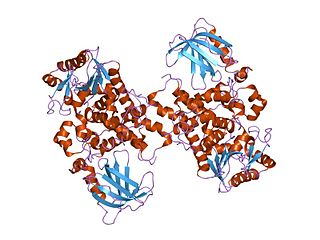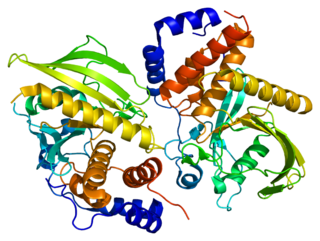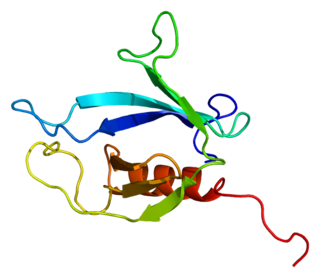
ABCD1 is a protein that transfers fatty acids into peroxisomes.

Myotubularin is a protein that in humans is encoded by the MTM1 gene.

Zinc finger protein 281 is a protein that in humans is encoded by the ZNF281 gene.

Myotubularin domain represents a region within eukaryotic myotubularin-related proteins that is sometimes found with the GRAM domain InterPro: IPR004182. Myotubularin is a dual-specific lipid phosphatase that dephosphorylates phosphatidylinositol 3-phosphate and phosphatidylinositol (3,5)-bi-phosphate. Mutations in gene encoding myotubularin-related proteins have been associated with disease.

Myotubularin-related protein 6 is a protein that in humans is encoded by the MTMR6 gene.

Myotubularin-related protein 2 also known as phosphatidylinositol-3,5-bisphosphate 3-phosphatase or phosphatidylinositol-3-phosphate phosphatase is a protein that in humans is encoded by the MTMR2 gene.

Tyrosine-protein phosphatase non-receptor type 9 is an enzyme that in humans is encoded by the PTPN9 gene.

Myotubularin-related protein 13 is a protein that in humans is encoded by the SBF2 gene.

Myotubularin-related protein 5 is a protein that in humans is encoded by the SBF1 gene.

Myotubularin-related protein 1 is a protein that in humans is encoded by the MTMR1 gene.

Dual specificity protein phosphatase 12 is an enzyme that in humans is encoded by the DUSP12 gene.

Dual specificity protein phosphatase 15 is an enzyme that in humans is encoded by the DUSP15 gene.

Myotubularin related protein 14 also known as MTMR14 is a protein which in humans is encoded by the MTMR14 gene.

Dual specificity protein phosphatase 23, also known as low molecular mass dual specificity phosphatase 3 (LDP-3), is an enzyme that in humans is encoded by the DUSP23 gene.

Myotubularin related protein 12 is a protein that in humans is encoded by the MTMR12 gene.

Jean-Louis Mandel, born in Strasbourg on February 12, 1946, is a French medical doctor and geneticist, and heads a research team at the Institute of Genetics and Molecular and Cellular Biology (IGBMC). He has been in charge of the genetic diagnosis laboratory at the University Hospitals of Strasbourg since 1992, as well as a professor at the Collège de France since 2003.

Dual specificity phosphatase 8 is a protein that in humans is encoded by the DUSP8 gene.

GRAM domain containing 1A also known as Aster-A is a protein that is encoded by the GRAMD1A gene. It contains a transmembrane region, a GRAM domain and a VASt domain that can bind cholesterol. GRAMD1A has four paralogs: GRAMD1B and GRAMD1C and two without VASt domains, GRAMD2A and GRAMD2B. These proteins are mammalian representatives of the yeast lipid transfer proteins anchored at a membrane contact site (LAM) family.

Inositol polyphosphate-5-phosphatase F is a protein that in humans is encoded by the INPP5F gene.

GRAM domain-containing 2A protein is a protein encoded by the GRAMD2A gene. Like GRAMD2B, the protein consists of a GRAM domain and a transmembrane domain that anchors it to the endoplasmic reticulum.






















